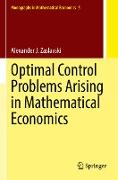Optimal Control Problems Arising in Mathematical Economics
BücherAngebote / Angebote:
This book is devoted to the study of two large classes of discrete-time optimal control problems arising in mathematical economics. Nonautonomous optimal control problems of the first class are determined by a sequence of objective functions and sequence of constraint maps. They correspond to a general model of economic growth. We are interested in turnpike properties of approximate solutions and in the stability of the turnpike phenomenon under small perturbations of objective functions and constraint maps. The second class of autonomous optimal control problems corresponds to another general class of models of economic dynamics which includes the Robinson縎olow縎rinivasan model as a particular case.
In Chap. 1 we discuss turnpike properties for a large class of discrete-time optimal control problems studied in the literature and for the Robinson縎olow縎rinivasan model. In Chap. 2 we introduce the first class of optimal control problems and study its turnpike property. This class of problems is also discussed in Chaps. 3� In Chap. 3 we study the stability of the turnpike phenomenon under small perturbations of the objective functions. Analogous results for problems with discounting are considered in Chap. 4. In Chap. 5 we study the stability of the turnpike phenomenon under small perturbations of the objective functions and the constraint maps. Analogous results for problems with discounting are established in Chap. 6. The results of Chaps. 5 and 6 are new. The second class of problems is studied in Chaps. 7� In Chap. 7 we study the turnpike properties. The stability of the turnpike phenomenon under small perturbations of the objective functions is established in Chap. 8. In Chap. 9 we establish the stability of the turnpike phenomenon under small perturbations of the objective functions and the constraint maps. The results of Chaps. 8 and 9 are new. In Chap. 10 we study optimal control problems related to a model of knowledge-based endogenous economic growth and show the existence of trajectories of unbounded economic growth and provide estimates for the growth rate.
Folgt in ca. 10 Arbeitstagen




